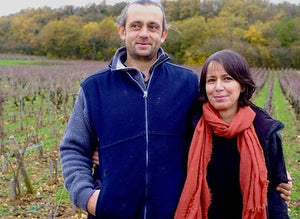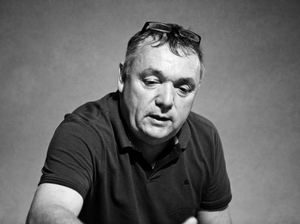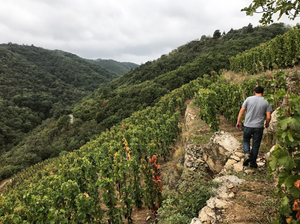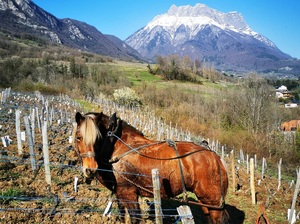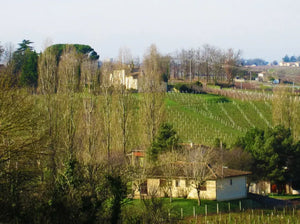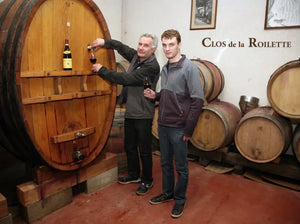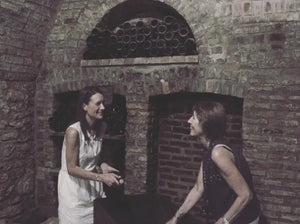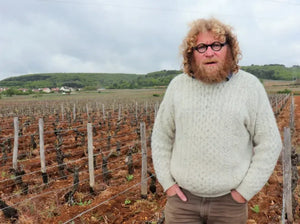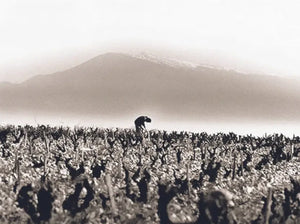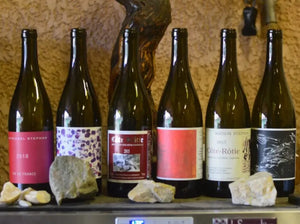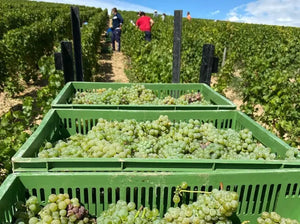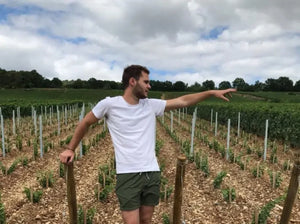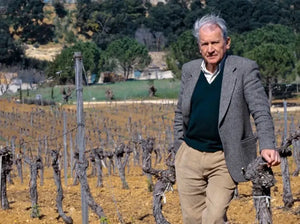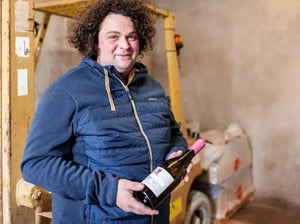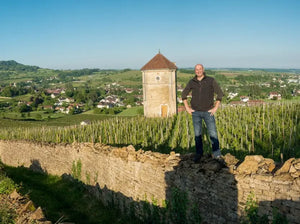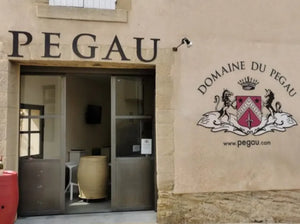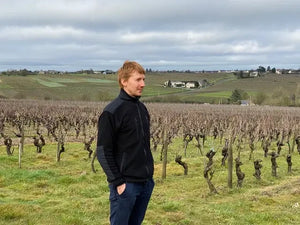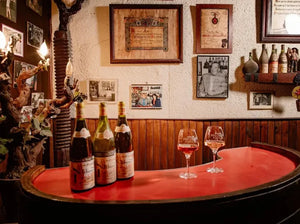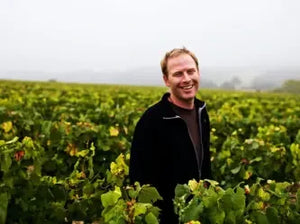Blog » France
-
Morey-Saint-Denis Icon: Hubert Lignier
Hubert Lignier is benchmark Morey Saint Denis, and one of Burgundy's most hallowed domaines. Over the last decade, Laurent Lignier has brought the domaine back to the heights of times past, under his father, where it was among the single most revered names in the Côte de Nuits. Always darker than the neighboring village of Chambolle-Musigny, the Morey wines from Lignier now show added lift and key freshness that have made them the envy of collectors throughout this new renaissance of late.
Lignier has been imported by Neal Rosenthal since the 1978 vintage, marking one of Neal's earliest and greatest successes. The style of the domaine has always been one that emphasized structure and distinct terroir-driven soil expression. Lignier's wines display the prototypical Morey rusted earth, black cherry, and a telltale hoisin note that the village is often associated with. However, as I mentioned, the style has recently shifted toward emphasizing the brightness of fruit and freshness as the foundation. -
Fleurie Rising: 2021 Yann Bertrand Beaujolais
Cru Beaujolais has been a cornerstone of our selection from the start. While Foillard, Métras, Lapierre, and Dutraive represent the foundation for the greatest value reds in France, the younger generation is now clearly making its mark. Yann may be separated from the aforementioned because of age, but when you line up his wines, it's crystal clear these are commanding interpretations of terroir.
Yann grew up in Fleurie, but after studying commerce in school and traveling through the Alps, he never expected to circle back to become its generation's brightest talent. He found himself working in a wine shop, and surrounded by passionate people, the flames of curiosity were stoked. He spent time working under perhaps the region's most revered names: Yvon Métras and Jean Foillard. Like them, Yann knew that organic farming and traditional methods in the cellar would be his path forward.
In 1992, Yann's family purchased vineyards and slowly converted them to organic farming. Yann took a more active role in leading the domaine in 2013, and he began applying what he had soaked up from his apprenticeships. Similarly, Yann's style is one of elegance, silken texture, and laser focus, expressing each unique terroir in the Famille Bertrand stable. -
Legend in the Making: Jura's François Rousset-MartinWhile Jean-François Ganevat and Stephane Tissot bridged many into the Jura (ourselves included), the name that has stirred us the most in the last few years is François Rousset-Martin. This 1,000-case annual production domaine was founded in 2007, but François has worked in wine his entire life. He began being imported a few years ago by Kermit Lynch––only Lynch's 2nd venture in Jura after Ganevat. When we first tasted the lineup, we were all blown away and immediately understood why Lynch waited decades to find a worthy addition to Ganevat.Rousset-Martin follows a similarly natural-minded approach, but the wines show more consistency. While the intense characteristics we love about Jura whites come through loud and clear (faint nuttiness, exotic orchard fruits, superb finesse), there's also a buffering salinity and lighting nerve under the wines that give them the total package.
François works in the non-oxidative style, ouillé, meaning barrels are topped up, versus the oxidative sous voile style. From the top wine today, Vigne aux Dames Savagnin, to the four brilliant Chardonnay cuvées, to the mind trip of a wine that is "Aligatõ," these whites are masterful in their composure and graceful contours––they follow a Burgundian aesthetic that grew from François' youthful days spent alongside his father who was a microbiologist for the Hospices de Beaune.The reds follow that same lean and silky frame that Ganevat introduced to us, but here, they are void of the volatile acidity and brett that can plague some bottles. These reds are clean and precise, with an intensity of fruit carried in a mid-weight package that makes them so easy to drink and with personality in spades. Cuvée 909 is the best Jura Pinot Noir I've had to date, and the Fleurie Poncié from one of the best vineyards in Beaujolais is a WOW wine in every sense that diverges from the region's other stars in its more linear focus that calls to mind his Burgundian roots.François farms almost two dozen small parcels (a hectare or less) in Château-Chalon and Côtes du Jura. Like the rest of the Jura, the soils are abundant in clay, but limestone and marl represent the core of the domaine's terroir.Wines are vinified parcel by parcel with little to no sulfur and bottled unfined and unfiltered. A natural approach in the cellar, with classic wines in bottle. -
Florence Cholet: Burgundy's Best Kept SecretFlorence Cholet's under the radar wines
-
Bitouzet-Prieur: Classicism Holding Steady
We all have regrets. One of mine was passing on Bitouzet-Prieur Volnay and Meursault when I turned on the lights in 2015. A friend once said, “If you’re not embarrassed by choices made in the previous year, then you’re not growing.” The 2020 vintage of this domaine marks my redemption.
With winemaking medals galore filling the home of Vincent Bitouzet back in 1860, the marriage to Annie Prieur after that marked the official start of what is now the most classic domaine in Volnay, along with Lafarge. And the whites from vineyards like Meursault 1er Cru Charmes and Perrières are now another great reminder that value is alive and well in the Côte de Beaune.
I only have a few wines from Bitouzet-Prieur, but they are the best cuvées to me after an extensive tasting with the domaine in Brooklyn last year. The Volnay is destemmed, and pigeage (punchdowns) occur twice per day—a process that has seemingly gone out of fashion in Burgundy of late as many opt for remontage (pumpovers) to bring softer contours and more immediacy to the fruit. But the 2020 Volnay is pure class and is precisely the type of Burgundy I seek out—from the greatest red village of the Côte de Beaune.
The whites see extended lees contact and a maximum of 20% new oak. They pull back on the fruity Chardonnay traits, instead digging deep for a saturating mineral through-line that reminds me of wines common pre-2005 heat. Still bursting with site-specificity and deliciousness, they take my mind back to another time with their soft-spoken spirit. -
André Ostertag: Alsatian Sensation
Domaine Ostertag has long gone against the grain of Alsatian expectations, crafting dry, disciplined wines that still summon the sunshine that marks the region. His Fronholz and Grand Cru Muenchberg Rieslings especially imbue the transparency and purity of a mountain lake. These wines are a moment of clarity for Alsace!
Alsace is in the cool northeast pocket of France, and its protection from the Vosges Mountains means it receives the least amount of rainfall of any region. This abundant sunshine has long given Alsatian wines a rounded and golden orchard fruit quality, often with a dollop of residual sugar. However, several elements separate Ostertag from the norm. André studied viticulture in Burgundy and returned home in 1998 to employ organic and biodynamic principles in the vineyard. He also decided to ferment his Rieslings completely dry and age them in stainless steel.
Today, Alsace is famous for having the highest percentage of organic and biodynamic producers in France. While the quality at harvest couldn't be higher, I still find few producers that execute with the same sense of harmony that Ostertag is adored for. -
Delectable Dijon: Domaine de la Cras
In the hills above Dijon, you can find one of Burgundy's greatest inception stories. It is a fresh departure from a domaine's normal evolution, but the wines in bottle are the most thrilling element from Marc Soyard. In a short time, Domaine de la Cras has gone from obscure to having a cult following.
A little over a decade ago, the city of Dijon purchased a vineyard just outside its limits, and they essentially held a casting call to find a winemaker for the property. The criteria were: The winemaker must be young, have no family vineyard holdings, farm organically, and open the domaine for educational tours. Rent for the land would be paid to the city in 2,000 bottles. Marc Soyard, originally from nearby Jura, was chosen.
Soyard does not come from a family of vignerons but previously worked for Vosne-Romanée's esteemed Domaine Bizot, known for its rigorous vineyard work, minuscule sulfur regimen, and whole-cluster fermentation. Soyard's Pinot Noirs pulled me in for their super crunchy and unadulterated bright, red berry fruit. The aromas are intoxicating even before tasting, and whole-cluster fermentation gives these wines a lifted spice and floral character that just floored me.
His Chardonnay's offer a totally unique take on white Burgundy, coming from this long-overlooked terroir––seamless and classic.
"Cras" Rouge & Blanc are the domaine's top wines from the oldest vines on the steepest portion of En Bessy.
Coteaux de Dijon Rouge & Blanc comes from 30-plus-year-old vines planted lower on the slope, with the rouge seeing 30% whole clusters being included for fermentation in wooden tanks without any sulfur additions.
Tercet is Soyard's lone Gamay––an upfront fruity style with imperceptible tannins.
-
Zero Fluff, All Focus: Jouan Morey 1er Cru Clos Sorbé
I'm often asked which Burgundy domaines should be on the radar for their classic character and no frills personality. The name atop that list, embodying both, is Philippe & Henri Jouan of Morey-Saint-Denis. Their greatest wine from their home village is the Premier Cru Clos Sorbé. The late, great Jacky Truchot once made this vineyard legendary, with bottles now fetching upwards of $2,000. When he retired (sort of) in 2005, he sold all his vineyards—except for Clos Sorbé, as he continued producing a tiny amount from a backyard site he cherished.
Today, Jouan carries the torch, crafting wines of incredible finesse with old-school sensibilities. And unlike Truchot’s now-mythic bottling, entry into this piece of Burgundy history is under $200.
Morey is often defined by what it isn't—neither Gevrey-Chambertin to the north nor Chambolle-Musigny to the south. Its wines trade Chambolle’s red cherry for darker berries, layered with forest floor and brown and rust-tinged earthy notes. And, unlike Gevrey’s muscular structure, Morey retains a grace and lift that always brings me back to a more Chambolle ethos of refinement.
Clos Sorbé centers around the same dark cherry fruit profile, but adding notes of orange rind, cocoa, and smoked game. All wrapped up with great acidity, fine-grained tannin, and unmistakable Premier Cru length and drive. While very structured in its extreme youth, with a few years in bottle, like today's 2020, these expressions are in full blossom.
-
Next Gen in Chablis: Vocoret's Bas de ChapelotEleni and Edouard Vocoret are among the latest producers you should know about in Chablis. With guidance from family and neighbors, including Vincent Dauvissat, the wines from this young domaine are already in Chablis' lead pack. The wines are rich in fruit, yet they're still founded on a Chablisienne core of bright minerality––the kind of white that appeals to the broadest net of palates imaginable.Highlights include Les Bas de Chapelot, located at the foot of Premier Cru Montée de Tonnere, famed for its ideal southern exposure and Grand Cru-like dramatics. It has a deep, saturating presence, an intense grip, and layers of citrus and white orchard fruits unfolding throughout the long finish.These wines came onto our radar three years ago and continue to wow us. The 2021 edition brings a verve and extra dimension of salinity that is so welcome after being preceded by a flurry of warm and dry vintages.Eleni and Edouard met while working harvest in New Zealand. In 2012, Edouard’s family gave the newlyweds their own five hectares of vines to tend to as they saw fit. They sold off the fruit for the first several years while tailoring the vineyard, then produced their first vintages in a family member’s garage. Formerly, Eleni worked as Vincent Dauvissat’s assistant winemaker, where she adopted much of his farming techniques, and Edouard apprenticed in Pouilly-Fuissé. This was an up-and-coming domaine, but now, after a few vintages, it's clear Vocoret is elite and will always be among the first Chablis names we reference.
-
Côte Rôtie's Wild Side: Jean-Michel StephanIn July 2012, a friend and I experienced our first Bastille Day celebration in epic fashion at the Lapierre's annual feast in Morgon. A few days later, it seemed fitting to meet Jean-Michel Stephan atop the steep terraces of Côte Rôtie, who notes Lapierre as his greatest model.Stephan takes a vinification approach that differs drastically from his neighbors in Côte Rôtie. Inspired by his time in Morgon, Stephan's philosophy employs carbonic fermentation, a process customarily reserved for Gamay in Beaujolais. Still, the most profound bottles hit the same mark as great traditionalists like Jamet and Benetière.As Stephan explained, all clusters enter fermentation tanks free of sulfur additions. He pumps in some CO2, closes the hatch, and walks away. When he returns, the intracellular or carbonic fermentation is complete. This method gives Syrah a less restrained primary fruit note, and the use of whole clusters counters that with spice and tannin, but in the end, it's the fresh streak within Stephan's cuvées I notice first.At first glance, Stephan's wines may seem like Côte Rôtie through a Beaujolais prism, but they offer a unique mineral streak and wildly aromatic range. The dark and brambly fruit is unadulterated by the complete absence of sulfur additions. With decanting, these young wines reveal a side of Côte Rôtie that makes it feel like it's your first time drinking Syrah.Les Binardes is 90% Syrah and 10% Viognier sourced from a single vineyard just below Côteaux Tupin. Aged in stainless steel tanks with zero sulfur additions.
Coteaux Bassenon is 60% Syrah, 30% Sérine, and 10% Viognier (the oldest vines were planted in 1896 and 1902). This parcel is on darker mica-schist soils in the northern part of the appellation, having qualities more commonly found in Côte Brune.
Coteaux de Tupin is 100% Serine. Vignerons remember it as the ancient clone of Syrah, a more oval-shaped berry, providing a darker take on the already wild Syrah variety and doubling down on the violet aromatic notes. Stephan's old Serine vines grow on granitic gneiss and white mica schist soils.En Coteaux is produced only in select vintages, sourced from the oldest Serine vines in Bassenon, and is supplemented with 15% of old-vine Viognier. -
Alt Rock Champagne: Vouette & SorbéeBertrand Gautherot's Vouette & Sorbée epitomes Aube Champagne's avant-garde. Since planting his vines in 1986 and bottling his first champagne in 2001, he has stood as the shepherd for this southern zone's revival. Certified biodynamic in 1998, his 5-hectare estate covers three vineyards of the same soils commonly found in Chablis to the south: Kimmeridgian and Portlandian.In the small village of Buxières-sur-Arce from this most southern zone of Champagne, a little more warmth and sunshine makes these non-dosage wines anything but austere. They are incredibly charming and enveloping upon release and hard to resist opening. However, some of my most memorable experiences with champagnes have come at the hands of aged Vouette & Sorbée. There is nothing to compare them to in the Aube, Montagne de Reims, Vallée de la Marne, or the Côte de Blancs.
Many have dubbed the 100% Chardonnay Blanc d'Argile "baby Selosse," and I can see why with its ripe and complex waxy yellow fruits with slight oxidative notes that are countered by intense salinity. At the opposite end of the cellar, you'd find the 100% Pinot Noir Fidele, which carries red berry fruits with supreme underlying mineral tension. The micro production finalés are the amphora-raised Textures (100% Pinot Blanc), Sobre (100% Chardonnay), and Extrait (100% Pinot Noir). All wines are produced in very small quantities with low sulfur additions at bottling. -
Rediscovered Bordeaux: Chateau Le Puy
In college, a Médoc was my epiphany red wine moment. In just one sniff, my growing fascination with wine shifted from California to France. Regrettably, those thrilling experiences via Bordeaux don't really come around anymore. The point-chasing, over-extracted, over-oaked, ripe-beyond-recognition style set in motion in the mid-80s has changed the region for the worse, and the pendulum has to swing back. Yet, terroir-driven producers do still exist.
Situated between Pomerol and Saint Emilion on the second-highest point along the Gironde estuary, Chateau Le Puy is a Bordeaux estate rooted in sensibilities more commonly found in Burgundy. The wines' finesse, transparency of place, and approachability are worlds apart from the stylistic norm in this revered region.These vines have been farmed free of chemicals since 1610, and today, full biodynamic practices are employed, with work done by horse. The estate's plantings include 85% Merlot, 7% Cabernet Franc, 6% Cabernet Sauvignon, and small percentages of Malbec and Carménère on an amalgamation of red clay, silex, and limestone soils.In addition to organic and biodynamic farming, their fermentation and élevage methods are also considered uncommon. Infusion and semi-carbonic methods limit the extraction of tannins, providing soft texture and bright, open-knit fruit out of the gate. Aging in large foudre preserves all of that backbone of mineral tension, bringing a freshness missing from the surrounding chateaux.The WinesDuc des Nauves sits at the lowest elevation on the property on a sandy limestone parcel and is fermented and aged exclusively in cement. It's one of the best values available in Bordeaux.Emilien is the main wine of the chateau. Its personality shows silken tannins and elegance that neighboring Pomerol is revered for. Aged in century-old foudres and neutral 228-liter Bordeaux barrels.Bartélemy comes from "Les Rocs," a parcel of old vines planted on deep limestone. Its structure, saturating texture, and persistence rival those under the region's famous classifications of 1855 and 1955. Aged in 228-liter barrels (Less than 10% new). -
Bona Fide Cornas: Domaine ClapeA visit to the Northern Rhone on my birthday started by hitting the road from Burgundy at dawn. The anticipation for the tour's next stop was all the fuel I needed: Domaine Auguste Clape.The style here has consistently pushed for maximum ripeness, picking at the last moment before the ominous fall rains begin. These fruit-forward Cornas from porous granite soils endow tremendous structure but with a pleasurable side of lusciousness. It's often argued that of the Big Three, including Hermitage and Côte Rôtie, Cornas offers an up-front approachability thanks to its southern and warm amphitheater setting. However, the savage scorched earth quality where Cornas derives its name is the foundation of this fabled domaine, and Clape captures all of that wildness.Clape's vineyards in Cornas span over ten parcels, including Allemand's Reynard and Chaillot and Nöel Verset's Sabarotte. This dizzying array of terroir plays a huge role in many decades of success. The wines are produced most traditionally with 100% whole cluster fermentation and aging in old barrels, with the two Cornas cuvées seeing 22 months in large foudre. When the opportunity arises to open Cornas with many decades on it, Clape is simply bulletproof. These young wines should not deceive you by their infancy's charming nature––they will go the distance to be enjoyed by generations to come.
Finding adequate words to place Auguste Clape in the context of Northern Rhone's history is difficult Auguste started bottling under his name in 1955 and stopped all négociant sales in 1968. Sadly, the day after I visited his son Pierre-Marie, he passed away at 93. Auguste pioneered the Northern Rhône in the company of Noël Verset and Raymond Trollat. -
Featherweight Corsican: Marquiliani Rosé"Drinking her rosé is like drinking a cloud. There's absolute weightlessness to it. Nothing is left on the palate but perfume." — Kermit Lynch, ImporterMarquiliani's rosé of Sciaccarellu from the east coast of Corsica is my personal favorite. I buy a wide range of rosés annually and even have favorite pairings for each, but the one that's captured my heart is Marquiliani's pale copper-hued, diamond-cut gems.
The native Sciaccarellu grape is grown here on decomposed granite terraces a couple of miles from the Mediterranean and just below the towering 8,000-foot Mount Renosu, ensuring cool breezes to balance out the island's hot summer temperatures.
The Vin de Corse is 95% Sciacacarellu and 5% Syrah and shows the more incisive and linear style of the domaine's rosé.
The smaller production Le Rosé de Pauline is 50% Syrah, 40% Sciaccarellu, and 10% Vermentino. Pauline is a touch broader on the palate but counterintuitively paler in color than the Vin de Corse. Even with Syrah's more prominent role here, this is still rosé at its most featherweight and saline-driven.
Along with her father, Daniel, Anne Almaric tends the minuscule two hectares of vines that her family took over in the 1950s. There was a 20-year span where this 200-year-old domaine had remained abandoned. Daniel was a pioneer, the first to plant Sciaccarellu on the island's eastern side. Anne's background in agricultural chemistry lent a keen eye toward viticulture, and the vines prospered under her watch. Some of the greatest rosés in the world come from domaines that produce red, white, and pink wines, but here every grape grown is only destined for rosé.
Marquiliani speaks from a very extreme edge of the general rosé landscape. It's wickedly precise, with an undeniable laser-like focus through its finish. It's mouth-watering and mineral-infused, with a texture that is so fine that if you think too hard, it may just vanish completely. The fruit spectrum is very much in the citrus realm, with grapefruit, faint passionfruit, and jasmine notes always hallmarks.Importer Kermit Lynch's quote above may be his most recognized one, and it captures what we love most about these pinks. Corsicans don't let much of this leave the island, so when given the opportunity each year, I bring in as much as possible. -
Pink Granite Rosé: 2023 Thivin BeaujolaisWhile Beaujolais red wines have always been a cornerstone, the region's more limited-production rosés never quite made the cut. That all changed when Kermit Lynch asked Château Thivin (our favorite producer in Côte de Brouilly) for a small amount of their rosé for California. From a single hectare of vines planted on pink granite atop the steep slopes of an ancient volcano—this is not your standard rosé.Pink granite and sand surround the ancient Mont Brouilly volcano, and here, on some of the steepest slopes in the region, Gamay is endowed with purple-toned fruits and wild lavender notes. I was hesitant before tasting, imagining those very bouncy and fruit-forward Gamay traits wouldn’t translate to the crisp and mineral personality I look for, but Thivin's rosé has a great sense of salinity and freshness. This rosé of Gamay is sourced from one hectare of 50-year-old vines. Grapes are pressed immediately, giving just a slightly pink hue. The wine is fermented with native yeasts, goes through full malolactic, and spends its life in stainless steel prior to bottling. As a result, it's a snappy and lively rosé that finishes with salty punctuation.This two-hectare was purchased at auction by Zaccharie Geoffrey in 1877. His grandson, Claude, was pivotal in creating the Côte de Brouilly appellation during the great depression. Now, his grandnephew, also Claude, his wife Evelyn, and their son Claude-Edouard are behind the production of this benchmark. Kermit Lynch visited the domaine during his first trip on the wine route with Richard Olney in 1976.
-
Burgundy's New Wave: Domaine DidonDavid and Naima Didon are today's most exciting examples of Burgundy's new generation. Coming to fruition in 2017, they have wowed us with their fresh and seamless wines crafted amid increasingly warming global temperatures, where these two traits are more elusive than ever. The inception story starts at an old farm in Chassey-le-Camp in Côte Chalonnaise, in Bouzeron––the only village whose legal status belongs solely to Aligoté. David is a veteran viticulturist, and after spending ten years consulting for Etienne De Montille in Volnay and time in the cellar with Julien Altaber, Domaine Didon was formed.David and Naima's two-hectare domaine relies on organic and biodynamic farming for Pinot Noir, Pinot Blanc, Chardonnay, and Aligoté. Their unique setting features dense yellow limestone on an east-facing slope, historically renowned as the best terroir in the village. Farming is done by horse and hand, without the use of tractors or heavy machinery, preventing soils from becoming overly compressed.They choose a hands-off approach in the cellar while still respecting and embracing new and alternative techniques. Whites are all whole bunch pressed, and the reds see a short 10-day maceration on skins. Wines are fermented in a mixture of vessels, including amphora, barrels, and fiberglass. All wines spend about a year on lees before bottling and remain unsulfured whenever possible. Like the best wines from this natural protocol, you don't consider them natural when you taste them. It's only their intrinsic connection to the fruit on the vine, with finesse and freshness, that captures the best qualities of everything natural wine done correctly.
-
Jean-Louis Dutraive: Fleurie's Bright Light
Jean-Louis Dutraive's entire stable of wines falls into the elite category of Cru Beaujolais. While he has various parcels in Fleurie, the Clos de la Grand Cour always thrills me for its lightness and ethereal pitch.
The Clos de la Grand Cour is a true walled-in vineyard, with up to 80-year-old vines growing on almost pure granite with a thin topsoil. The wine ages 35% in stainless steel, 30% in fûts de chêne, and 30% foudres for 9 to 12 months. Lifted spices meet fresh raspberry and cherry to give a delicate wine with a deep texture and a long finish.
The old-vine cuvée, Le Clos, takes the concentration and intensity up with darker red fruits and penetrating salinity. With its deeper soils, the Chapelle des Bois gives a more satiny texture with less incisive minerality. And the Brouilly shows a more muscular side of Dutraive's still charming and approachable form.
Compared to other titans of Beaujolais, I find Dutraive's wines are often lighter in color, with more lifted spice and a wild, natural element that stands out due to a low sulfur protocol. I try to wait several years after release to tap into these top cuvées. Aged Dutraive is pure magic when fruit begins to fall to the background, and exotic spices become more prominent.
The 2022s are a giant success at this address and prove that Jean-Louis is still one of the benchmarks of the Beaujolais.Photo by Ted Vance
-
No Stone Unturned: Jean-Louis Chave in St. Joseph
Since 1481, there have been 16 generations of unbroken lineage at the Chave estate along the Rhone River's towering granite slopes. When we look closely at the birthplace of Syrah, there's no name more respected than that of Jean-Louis Chave.
Saint-Joseph's boundaries have expanded immensely since the appellation gained AOC status in 1956, but Chave's choice parcels still represent the best and most serious terroir. Here, there's an underlying mineral component that provides the backbone to their wines, and it's this definition that allows them to age effortlessly. Examples of Saint Joseph from the late 1990s have floored me with their sense of vivacity, freshness, and regal structure.
Jean-Louis Chave joined his father Gérard in 1992 after completing his studies in enology at UC Davis. Once home, his primary mission was to re-plant the steep slopes of Saint Joseph—the same hillside where the domaine first began, but the vineyards laid fallow since the 19th century when phylloxera decimated them. Jean-Louis knew these treacherously steep hillsides in Saint Joseph could produce a magnificent yet value-conscious alternative to Hermitage.
It's been nearly three decades since these terraces were re-built by hand, and vines were re-planted among traditional échalas stakes. Today, the results are stunning wines that remind us the root of Rhone's success comes from hands-on work and attention to detail, something the Chave family has personified for hundreds of years.Photo Credit: Grand Cru Selections
-
Young gun in Savoie: Nicolas FerrandCurious about alpine red wines? Then, you have to check out the Savoie's native red grape variety, Mondeuse. One of the best examples we’ve encountered comes from the young Nicolas Ferrand. We spread the word to as many of our customers as possible and are down to only a few cases.
Coteau de la Mort ($79) has the depth of Northern Rhône Syrah, with high-toned black cherry, black pepper, and pressed rose petals, though this Mondeuse is also surprisingly juicy and sleek. Ferrand does a semi-carbonic fermentation without any piegeage (pressing of the skins), no fining or filtering, uses minimal sulfur, and ages in larger format barrels.The cuvée's name, hill of death, refers to the ancient hillside vineyards re-planted during Savoie’s renaissance in the 1990s, thanks to early champions, like Michel Grisard of Prieuré St-Christophe, who I've written about in past offers. In 2013, the vineyard fell under the stewardship of Ferrand when starting Domaine des Côtes Rousses.
One of the Savoie’s top crus for Mondeuse, Saint Jean de la Porte has distinct red clay soils (the inspiration behind the domaine name), as well as limestone and moraine. Ferrand has farmed organically from the beginning and utilizes horses and sheep in partnership with his neighbors. He's native to the area, but his family previously farmed cattle, making him a first-generation vigneron.In the last decade, Ferrand's vineyard holdings have increased, and so has the buzz for his wines. Savoie expert and author Wink Lorch says, “Nicolas’s wines should become a staple in every Savoie wine lover’s cellar,” and we fervently agree. Coteau de la Mort is a refreshing take on Savoie history. -
The Real St-Émilion Deal: Chateau Tertre de La Mouleyre
Chateau Tertre de La Mouleyre is not your typical Grand Cru Bordeaux, but it is the real Saint-Emilion deal. The 2016 vintage left me so in awe that I took every case allocated to California, with only 350 cases produced annually. Those are long gone, but I've gone deep on every release since then.
To place Chateau Tertre de la Mouleyre in the garagiste category would be a mistake. While they don't have the same typicity as grand chateaux in the classified growths, they marry the two philosophies for the perfect storm: Bordeaux ready to drink upon release with immaculate construction.
The blend is 80% Merlot and 20% Cabernet Franc from 50-year-old vines. 35% ages in large neutral cuve and 65% in new French oak barrels. I'm immediately inclined to describe this gem as old school and traditional, but its warmth and charm afforded by today's climate carry a level of finesse and complexity that is pure Grand Cru.
Tertre de la Mouleyre is named after the windmill atop the clay and limestone slope in St-Étienne de Lisse. From a young age, Eric Jeanneteau helped his grandfather in the vines, and his interest never diverged for a moment. After three degrees in viticulture and stints at grand chateaux, Eric returned home to implement a full organic regimen to his family's vines. -
Fleurie Benchmark: Clos de la RoiletteBy nature, most Gamay-based wines from the Beaujolais are opened within a year of release, but the wines of the Coudert family are best known for their unrivaled complexity and track record for aging.One year, at La Paulée's verticals tasting, 31 tables were filled with the best of Burgundy (Roumier, Lafon, Rousseau, Mugneret-Gibourg, D'Angerville) and one sole Cru Beaujolais (Roilette). Set alongside Burgundy's most elite producers, the tasting was a great reminder that the best of Cru Beaujolais greatly rewards the patient.The story of Roilette's evolution is a fascinating one. The vineyards were historically classified as Moulin-à-Vent, and its owners are proud of that designation. But in the 1920s, districts were re-drawn, and the Fleurie appellation was created. This newfound appellation, which was required to appear on the label, enraged the owner of the Clos de Roilette. Instead of printing Fleurie, he used a photo of his racehorse and refused to sell his wines in France, exporting 100% of his production to neighboring countries.In 1967, ownership changed hands, and this largely untended vineyard went into the thoughtful stewardship of Fernand Coudert. Today, the wines are widely regarded as the benchmark of not only Fleurie but the entire Beaujolais region.The border of Moulin-à-Vent and Fleurie, where the estate sits, is home to clay-dominant vineyards. Whereas most of Beaujolais is on granite, the clay and manganese soils of Roilette give a darker and richer expression of Gamay. Blue and black fruits are abundant in all of the estate's wines.Roilette's Fleurie bottling comes from a parcel of 30-to-45-year-old vines and undergoes the same whole cluster, semi-carbonic fermentation regimen as the estate's Cuvée Tardive and Griffe du Marquis. Stylistically, the Fleurie is open-knit and has a more supple tannin structure, still with the stuffing to age gracefully and develop over the next few years.
-
House Champagne Hero: J. Lassalle
Champagne from the grower-producers is better than ever. The writing was on the wall when I was living in France in 2012, and it felt like a sea change was underway––I was probably late to notice, but still, names like Agrapart and Chartogne-Taillet became part of my weekly hauls from the local shops in Beaune. One of the names that I was introduced to early on was J. Lassalle. And, though their entry-level pricing has remained astonishingly low at $40, all their champagnes punch well above their price point.
The rosé champagne is a wine that holds a special place in my heart within its category. The pale copper-hued stunner has perfect balance and expertly judged ripeness and dosage. However, I'd be remiss if I didn't use this time to talk more in-depth about the Cachet d'Or 1er Cru Brut Réserve––at $40, it's the most obvious price anomaly in the world of grower-champagne. Aged for three years on lees before disgorgement, it carries both the rich brioche notes you'd desire, with all the finely-woven chalky minerality that is a prereq to go hand-in-hand with the more recognized grower names that sell for double the price. The blend is as classic as the style––equal parts Pinot Noir, Pinot Meunier, and Chardonnay, all from 50+-year-old vines in Premier Cru villages in the Montagne de Reims.
In 1982, after founder Jules Lassalle's passing, his wife, Olga, and their daughter, Chantal, took the reins. In 2006, Chantal's daughter, Angéline, took over as winemaker. "Une femme, un esprit, un style" (one woman, one spirit, one style). The inimitable Kermit Lynch has imported J. Lassalle for over 50 years––the longest relationship in his portfolio of legendary names. -
Designations be Damned: Sylvain Pataille Marsannay
Sylvain Pataille is famous for three things: Producing some of the most texturally seamless and balanced wines in the Côte de Nuits, his oenologist consulting for over 15 domaines, and having really awesome hair. My visit to the domaine was a terroir masterclass, as we tasted over 20 wines from Marsannay.
Marsannay and Pataille are a match made in heaven. Both have seemingly flown under the radar for far too long. Search through any savvy Burgundy collector's cellar, and next to the Rousseau and Dujac, you're sure to find a host of Pataille's Marsannay. This village located above Gevrey Chambertin has a complicated history, though. Mainly planted with Gamay at the time of classifications, no vineyards could receive a status higher than villages.
Today, Clos du Roy would undoubtedly be a Premier Cru, and it's a steal within the hierarchy of Burgundy's elite. There's never shyness here, always finding that elusive mix between power, elegance, and silken tannins without overt new oak influence. And, believe it or not, Le Chaptire's historical pricing in the 16th century was only surpassed by Chambertin-Clos de Beze. It's still among the ultimate insider lieu-dits and an equally worthy cellar mate with Clos du Roy. -
Chateauneuf Harmonics: Domaine du Vieux Télégraphe
Southern Rhône rarely struggles with ripeness, but finding harmony in even the top cuvées of Chateauneuf can be challenging. That's why the 2020 vintage has been on my radar. If there's one characteristic that this vintage has endowed, it is balance and refinement. And, no domaine executed better than Kermit Lynch's iconic import, Domaine du Vieux Télégraphe. Situated in the far southeast of the appellation on the enviable high-elevation plateau known simply as "La Crau", the Brunier family began tending these vines in 1898. If there is a CdP Grand Cru terroir, this is it. Iconic and mesmerizing bottlings stretch back decades (see below) from the brothers Daniel and Frédéric.
The tell-tale signs of Brunier's CdP are always a red fruit dominant core with rose petals, inimitable garrigue, smoke, and a strong mineral presence that combines with the sturdy but rounded tannins to allow these to develop for decades. A bottle of 1988 that I opened earlier this year was a revelation, though expectations are always high when old bottles of VT with excellent provenance make their way to the table. 2020 is the most anticipated vintage for me since the 2016 release. 2020 is one of those vintages that has it all for the southern Rhône––finesse, concentration, palate-gripping intensity, and a fresh, crisp finish. -
We're Gonna Need a Bigger Boat: Maison Stephan Syrah
We reserve our biggest boats for the most prime catches. Today that means Jean-Michel Stephan's first-time cuvée from Syrah vines planted just outside Côte Rôtie's zone. This 100% Syrah, labeled Vin de France, was the most transcendent find for us in a long time. At $39 per bottle, this wowed us for its Côte Rôtie-like concentration of blackberry fruit, roasted meat notes, with loads of lavender and black pepper––the intensity we're accustomed to finding in bottles well over $75.
Maison Stephan's Syrah comes from just one hectare of vines in Ampuis and Chasse-sur-Rhône. As is the norm here from a Marcel Lapierre disciple, Stephan relies on carbonic and semi-carbonic fermentation with native yeasts and zero additives. Unfiltered and unfined without sulfur. Aging six months in stainless steel means this 2022 harnesses the primary fruit from the sunny growing season and has a fresh streak on the finish that screams granitic minerality.
We see this as an ideal option for holiday feasts with chicken, pork, beef, and lamb, and it will also be brilliantly served with a slight chill once we enter spring and summer 2024. We love Syrah, and this is our value champion of 2023. -
Sancerre Secret: Vincent Pinard FlorèsOne thrill of living in Beaune in 2012 was getting familiar with an enormous range of Burgundy producers. Beaune had its fair share of wine bars, and none devoted serious space to wines outside the region. That changed when the natural-focused Les Vins de Maurice opened in the spring, where wines from the Jura, Rhone, and Loire Valley covered the walls.
One day, I asked Maurice to introduce me to a new producer doing something unusual, and he quickly picked up a bottle of Vincent Pinard's Sancerre. I've been hunting for his wines ever since, brought to the U.S. by the same importer as Mugnier, Comte Liger-Belair, and Lafarge.
Pinard is in the village of Bué—some of the most prized vineyards in the region are here (alongside Chavignol). His wines are overtly stylish, each cuvée standing apart from one another. They have intense concentration and a gossamer texture that bears little resemblance to what we commonly expect from Sancerre.
Florès comes from a collection of vineyards in Bué. Aged in stainless steel tanks, the racy and crispy classic Sauvignon Blanc citrus notes mesh perfectly with Pinard's more layered and textural style. When fall hits, and I reach for Sancerre, this is the kind of secret overachiever that delivers! -
Leaping Over Legacy: Pierre Girardin Bourgogne
Vincent Girardin's name was synonymous with Burgundy's breadth, with wines coming from enviable vineyards throughout the Côte d'Or. Although the vast terroir had undeniable gems from Grand Crus and Premier Crus, the large production made for boring wines. When Vincent sold the domaine in 2011, he kept 4.5 hectares of the top holdings for his son, Pierre. After spending time in the vines, cuverie, and cellar from a very young age, the 21-year-old Pierre wanted to take a different philosophical path with his label. He was determined to be associated with the highest quality work––albeit with much more limited availability.
As the cuvée's label suggests, calcaire (limestone) is what Pierre wants to express, and the lens of terroir is in focus with these terrific Bourgogne wines. Pierre's methods highlight freshness and finesse––a rare move was selecting considerably larger 456L barrels for aging and favoring punchovers (as opposed to punchdowns) for the reds to keep their tannins silken. The value proposition in Burgundy is one that we bring up a lot. No doubt, pricing keeps climbing, but the emergence of new values is always around the corner. Pierre Girardin is a name that delivers in a big way with a relatively low price tag, given the quality and terroir. -
Languedoc's Jewel: Mas de Daumas Gassac
Outside of the iconic Cabernet Sauvignon addresses in Bordeaux, there's one name in France that can go toe to toe with these chateaux: Mas de Daumas Gassac. As always, the provenance of older wines is a critical factor in the quality you'll find in the glass, and I'm thrilled to offer this mint condition collection from Languedoc's star estate.
Mas de Daumas Gassac was established in 1970 when Véronique and Aimé Guibert came across an abandoned farmhouse owned by the Daumas family along the Gassac River in the Herault. Underground water springs and surrounding mountains created a microclimate mirroring Bordeaux's Médoc, so they planted vine material from First Growth chateaux in Bordeaux. The region has an abundance of 100-plus-year-old plantings, with a dry climate favorable for organic viticulture.
Made of 70% Cabernet Sauvignon supplemented with Cabernet Franc, Merlot, Pinot Noir, Tannat, and Malbec, the wines highlight espresso, dark chocolate, cigar box, brambly blackberries, and savory spices. Still, Languedoc's cooling influences and limestone bedrock have long stood out as a beacon for freshness. Alcohol levels have remained modest through stylistic shifts, never taking Bordeaux's cues when things drastically changed in the '80s. -
Burgundy Fireworks: Yann Charlopin-Tissier
A June 2016 visit in Burgundy meant tastings with some of my favorite storied domaines like Mugneret-Gibourg and Denis Bachelet, but it was after a lunch with Jeremy Seysses at Domaine Dujac and a beautiful bottle of 1993 Clos de la Roche that I got tipped off to something happening across the street—the new Domaine Charlopin-Tissier.
Yann Charlopin-Tissier’s background is surrounded by legendary figures. His father, Philippe Charlopin, was a student of Henri Jayer as he started his own domaine in 1978. Yann worked closely with his father starting in 2004, and then with another mentor, Jean-Marie Fourrier, before launching his own domaine, now at just 4 hectares. Like these Vosne-Romanée and Gevrey Chambertin mythic names, Yann favors picking as ripe as possible and prefers de-stemming.
Yann filled me in on his methodical and organic approach to viticulture, his excruciatingly low yields, and his disdain for talking too much about winemaking choices in the cuverie. "These wines are made in the vineyard," he would repeat. And the dirt under his nails, and muddy boot prints littered throughout the courtyard drove home that point. For me, this image greatly juxtaposed with what you find in bottle––suave and sophisticated texture, luxurious mouthfeel, supported by very concentrated ripe fruit buffered with mouth-watering salinity.
My two favorite wines of the 2020 vintage capture precisely what is so special here: The Marsannay La Montagne is surely the sleeper pick in the range, but this lieu-dit coming from the top of the slope in Marsannay where it is substantially rockier than below offers a masterclass in balance, between bold, ripe, dark fruit with powdery tannins and mineral finish. The Pernand Vergelesses Sous Frétille is one of best kept secrets in Premier Cru white Burgundy. Always a site that delivers crisp salinity and a Grand Cru-level drama. Yann’s version has a ruthless intensity of fruit with a chalky grip that is truly head-turning. This reflects his ambition for powerfully concentrated wines that still somehow have a wizardly refinement on the palate. -
Stéphane Tissot's Jurassic Bubbles
There's no producer in the Jura that executes brilliance across such a diverse range of wines and styles like that of Stéphane Tissot. And, "BBF" is the sparkling white from the Jura that you've always wanted to find in your glass. As a category, Cremant du Jura can be delicious and pleasing but rarely would take your mind to Champagne. BBF delivers here.
The name is a play on the use of 228-liter barrels for elévage, Blanc de Blancs élevé en Fût. Where this benchmark Cremant du Jura diverges from champagne is in its faint nutty aromas, baking spices, and ripe tropical notes. However, the structure is as serious as much of what you are to find from the Aube, with even more salinity and razor-fine cut reminiscent of the Côte de Blancs.
Tissot took control of his family's domaine in 1990 and worked very quickly to drastically reduce yields and convert the vineyards to organic and biodynamic viticulture. Today, Stéphane is seen as one of the world's most respected and prominent voices on the subject.
Tissot's Chardonnays each have that unmistakable reductive, flinty note that's often referred to as Noble Reduction. If you're a fan of the wines of Jean-Marc Roulot and Coche-Dury in Meursault, this distinctive smokey and matchstick trait, at its best, adds mesmerizing personality to Chardonnay.
-
Châteauneuf du Pape CélébritéIn Châteauneuf du Pape, walking the fine line between elegance and rusticity is difficult, but Domaine Pégau embodies the precision of this balance like none other. Their progression over the last ten years to highlight a more lifted style while maintaining a sense of opulence is a hot topic for lovers of the Southern Rhône Valley. While the estate produces several cuvées, their Cuvée Réservée fulfills the best value and sharpest focus on this fabled terroir.
The Reservée has always been the prime CdP for value, but Laurence's recent move to raise the Grenache and lower the Syrah percentage in the blend has done wonders for its clarity and persistence. Licorice, dark fruits, woodsmoke, game, and wild garrigue are hallmarks of every bottle of CdP. Pégau captures these notes with an impressive mineral streak and fine-grained tannins that stand out from the pack. A rack of lamb alongside Pégau has become one of my ultimate pleasures.
Laurence Féraud works with her father, Paul, in carrying on a steep tradition started by their ancestors in 1607. The backbone of the estate is their old Grenache plantings dating back to 1907 in the famed La Crau vineyard, where limestone mother rock sits below the iconic, round galet river stones. They use whole clusters for vinification, and the wines age in large foudres crafted nearly a century ago. Both elements are crucial in preserving a sense of vibrancy in their Grenache-dominant blends.
Truth be told, the Southern Rhône pulled me into France way back when I was finishing college. Today, I pull bottles from this region with much less regularity—much of that has to do with producers chasing after power and points. However, Pégau never succumbed to altering their methods. I can't tell you how refreshing it is to have a select few producers that still makes wines that they love to drink and their ancestors would be proud of today. Pégau is everything sacred about tradition and should be celebrated as often as possible. -
Provence Icon: Domaine Tempier Bandol RoséIn 1941, Lulu and Lucien Peyraud put Bandol on the AOC map by petitioning for official recognition. Today, Domaine Tempier is perhaps more synonymous with its appellation than any domaine in France. While there's a push each year to get the new vintage of their rosé on the market to quench the ever-increasing thirst of summer's appetite, the best of Tempier's rosé is always yet to come through bottle development.
Domaine Tempier's 2022 Bandol Rosé just arrived, plus a restock of the 2021 vintage is on the way! The rosé blend is 55% Mourvèdre, 25% Grenache, and 20% Cinsault, planted on limestone and clay soils above the Mediterranean Coast. The secret to this highly coveted pink is its ability to transform over time while holding onto that critical freshness. Visiting the domaine in July 2016 proved these back-vintage rosés and reds deserve their place among France's most cherished estates.
-
Anjou Outlier: Pierre Menard's Old-Vine Sauvignon Blanc
Pierre Menard reaches cult status in Europe for his lieu-dit (single-vineyard) Chenin Blancs. Simply put, Chenin gets the prime slopes in Anjou, where schist dominates, and the flatlands may see some Sauvignon Blanc. However, Menard discovered one of the first Sauvignon Blanc parcels in this region, the tiny 1957-planted Clos de la Roche atop a slope in Faye d'Anjou.
Before tasting Laïka, one should expel any notion of what this variety delivers. Typical grapefruit and lime fade into the background—much like earth did when the first living creature, a dog named Laïka, was rocketed into space in 1957—those flavors are replaced by saffron butter, a kaleidoscope of yellow fruits, and a mineral underpinning that only Anjou's schist-laden slopes convey.
Only a few cases of Laïka enter the U.S. each year. Also, do not miss Menard's stellar Chenin Blancs in equally small quantities. While we don't focus on many sweet/dessert wines, the "Cosmos" Coteaux du Layon (500 ml) blew us away. Perfect for pairing with cheese or dessert, but save the chocolate for Port! -
1793-Outlier: Provence's Clos Cibonne Rosé
That was the year the Roux family purchased the estate from Jean-Baptiste de Cibon and planted the rare goblet-trained Tibouren red variety. Tibouren is as obscure as the style of rosé that has been made here for centuries. And, the single red wine example from Cibonne is a departure stylistically from most Provence reds, as its lighter-bodied style and elegant personality strut their stuff when bottles are served chilled––a perfect summertime red.
The Cibonne rosés (five of them) are the main attraction here, and rightfully so, as they can all age and develop positively for a decade or more. Cuvée Tradition is aged in 100-year-old foudres sous-voile (under a thin veil of flor) giving faint hints of briny clementines and almonds. The fruit is not emphasized in this rosé like most, instead, notes of cardamon and anise take a prominent role next to the white peach and strawberry foundation.
If there's one thing that impresses all who drink Cibonne's rosés for the first time, it is surely the un-ending finish that lingers with spice and salty fruit thanks to the proximity of Cibonne's vines from the Mediterranean, just 800 meters away. If you've ever wanted a jolt of excitement for Provence reds or rosés, this is the historic domaine you need to try. -
Chablis King in Waiting: Patrick Piuze
It's overwhelmingly agreed that Raveneau and Dauvissat represent the most crowning achievements in Chablis, but Patrick Piuze is a king-in-waiting. Piuze is a wizard at working with stainless steel and oak to craft Chardonnay from Chablis' fossilized ancient sea bed that delivers the grandeur expected from these top vineyards. Like Raveneau and Dauvissat, it's the regal structure, seamless contours, and definitive cut married to this breadth that places Piuze in elite company.
Wine critic William Kelley on the vintage:
"2020 is another excellent vintage at this address, and even if the two years were very different on paper, it might be compared to a more extroverted, open-knit version of the superb 2017 vintage at this address... The resulting wines are elegantly textural but incisive, clearly differentiated by site. This is also the best address to explore the village-level Chablis AOC, as Piuze produces a number of cuvées and lieu-dit bottlings designed to highlight the diversity that this large appellation encompasses."
.svg?v=162776257677185172071724397232)


















